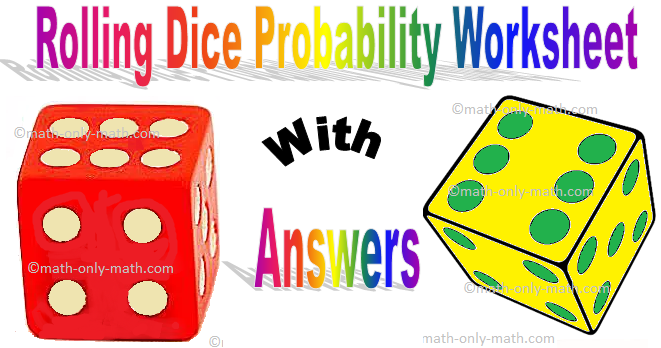Subscribe to our ▶️ YouTube channel 🔴 for the latest videos, updates, and tips.
Rolling Dice Probability Worksheet
Practice different types of rolling dice probability questions like probability of rolling a die, probability for rolling two dice simultaneously and probability for rolling three dice simultaneously in rolling dice probability worksheet.
1. A die is thrown 350 times and the score of 6 is obtained 28 times. Find the probability of
(i) getting the score of 6
(ii) getting a score under 6.
2. A die is rolled 500 times and the frequencies of the scores obtained are given below.
Score
1
2
3
4
5
6
Total
Frequency
75
80
85
90
84
86
500
Find the probability of getting each score. Verify if their sum is 1.
3. Write down the total number of possible outcomes when the following experiment is done.
(i) A die is rolled
(ii) Two dices are rolled simultaneously.
4. A die is rolled at random. Write the number of favourable outcomes for the following events:
(i) getting a number less than 5
(ii) getting a prime number.
5. Two coins are tossed simultaneously. Write the number of favourable outcomes for the following events:
(i) getting at least one tail
(ii) getting tail
6. Fill in the blanks.
(i) A die is rolled at random. The probability of getting 2 is ....... .
(ii) A die is rolled at random. The probability of not getting 4 is ....... .
7. A die is rolled once. Find the probability of getting
(i) the number 5
(ii) an odd number
(iii) a number lying between 3 and 6
8. A die is rolled once. Find the probability that the number is
(i) even
(ii) greater than 2
9. Two dice, one white and one red, are rolled together. Find the probability of getting
(i) a sum of 6
(ii) two different digits
(iii) a difference of 1.
Answers for the rolling dice probability worksheet are given below to check the exact answers of the above questions.
Answers
1. (i) \(\frac{2}{25}\)
(ii) \(\frac{23}{25}\)
2. \(\frac{3}{20}\), \(\frac{4}{25}\), \(\frac{17}{100}\), \(\frac{9}{50}\), \(\frac{21}{125}\), \(\frac{43}{250}\); Yes
3. (i) 6
(ii) 36
4. (i) 4
(ii) 3
5. (i) 3
(ii) 1
6. (i) \(\frac{1}{6}\)
(ii) \(\frac{5}{6}\)
7. (i) \(\frac{1}{6}\)
(ii) \(\frac{1}{2}\)
(iii) \(\frac{1}{3}\)
8. (i) \(\frac{1}{2}\)
(ii) \(\frac{2}{3}\)
9. (i) \(\frac{5}{36}\)
(ii) \(\frac{5}{6}\)
(iii) \(\frac{5}{18}\)
● Probability
- Probability
- Definition of Probability
- Random Experiments
- Experimental Probability
- Events in Probability
- Empirical Probability
- Coin Toss Probability
- Probability of Tossing Two Coins
- Probability of Tossing Three Coins
- Complimentary Events
- Mutually Exclusive Events
- Mutually Non-Exclusive Events
- Conditional Probability
- Theoretical Probability
- Odds and Probability
- Playing Cards Probability
- Probability and Playing Cards
- Probability of Rolling a Die
- Probability for Rolling Two Dice
- Probability for Rolling Three Dice
- Solved Probability Problems
- Probability Questions Answers
- Coin Toss Probability Worksheet
- Rolling Dice Probability Worksheet
From Rolling Dice Probability Worksheet to HOME PAGE
Didn't find what you were looking for? Or want to know more information about Math Only Math. Use this Google Search to find what you need.



New! Comments
Have your say about what you just read! Leave me a comment in the box below. Ask a Question or Answer a Question.